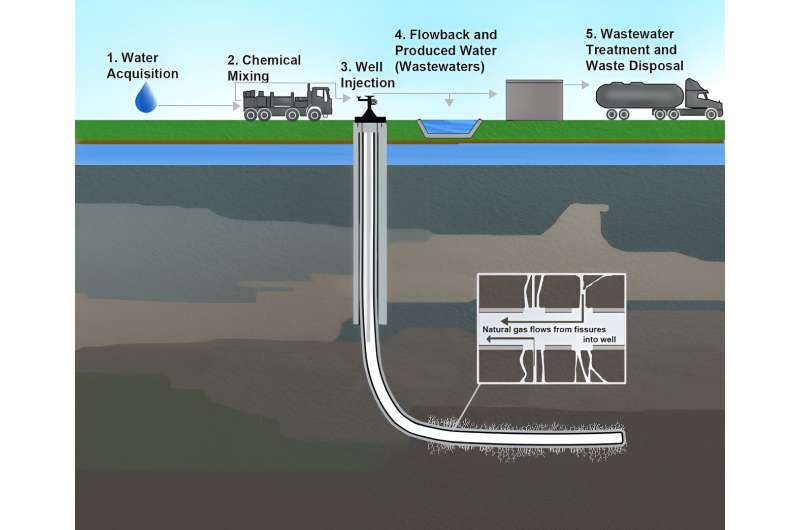This article has been reviewed according to Science X's editorial process and policies. Editors have highlighted the following attributes while ensuring the content's credibility:
fact-checked
proofread
Analysis of transient linear flow-oriented straight-line analysis technique to capture fracking data

As an efficacious solution to conventional resource depletion, unconventional reservoirs have emerged in a dominant role in furnishing substantial oil and gas supplies worldwide.
For unconventional reservoirs, the primary hurdle pertains to the assessment of the stimulated permeability and the success of completion design based on time-dependent patterns in flowrate and pressure, which holds paramount significance in the context of long-term reservoir management, including strategies like enhanced oil recovery and post-depletion CO2 storage and sequestration.
Consequently, the analysis of production data through the RTA technique emerges as an effective tool to assess the effectiveness of well stimulation.
To meet the requirements of new theories and methods for efficient evaluation and utilization of unconventional resources, Professor Chen and his team from the University of Calgary, Canada, reviewed the advances and challenges in transient linear flow-oriented straight-line analysis techniques for the evaluations of unconventional reservoirs.
"Despite the effectiveness and simplicity of the straight line analysis (SLA) method, there is a lack of a comprehensive guide for applying SLA in various transient linear flow regimes and different unconventional reservoirs," remarks Prof. Chen regarding the motivation for their study.
Their findings were published in Energy Reviews. In the review article, the team summarizes the classification of transient linear flow, basic straight-line analysis technique and its modification method for different reservoirs, its special application in core analysis and flowback analysis, and they propose the future research direction and challenges of this technique.
Transient linear flow (TLF) is the dominant flow regime in hydraulically fractured wells drilled in unconventional reservoirs, such as hydraulically fractured vertical wells (HFVWs) and multi-fractured horizontal wells (MFHWs). There are generally two common transient linear flows, i.e., formation linear flow and fracture linear flow.
According to the relationship between fractures, wells, and the formation, TLF can be further divided into four types: intra-fracture transient linear flow (IFTLF), bi-linear flow, inter-fracture formation transient linear flow (IFFTLF), inter-well formation transient linear flow (IWFTLF).
Analyzing different types of transient linear flows can provide various information related to fractures and wells, such as fracture half-length, fracture conductivity, fracture width, and effective producing well half-length.
Modifying straight-line analysis techniques for the storage and flow characteristics in different reservoirs is essential. This can enhance the accuracy of parameter estimation and broaden the application scope of the technique while retaining its simplicity and ease of operation.
Compared to other methods, such as numerical simulation, using transient linear flow-oriented straight-line analysis method to obtain information related to different fractures and fluid reserves is convenient, time-saving, and reasonably accurate. The alternative straight-line analysis method introduced in the article is still in the early stages of development.
Certain reservoir or flow characteristics may affect the appearance of straight-line segments in the straight-line analysis method, such as multiphase flow, reservoir heterogeneity, anomalous diffusion, etc. Therefore, in subsequent research, improvements can be made to the alternative straight-line analysis method to address these characteristics.
Additionally, Bayesian algorithms or other machine learning algorithms can also be combined with the straight-line analysis method to narrow down the estimation range of fracture parameters. Moreover, microseismic data and fractal geometry theory can also be applied to straight-line analysis techniques to quantitatively describe complex hydraulic fracture networks quantitatively, thereby further enhancing the accuracy of fracture parameter estimation.
"The transient linear flow oriented straight-line analysis technique can assist petroleum engineers in understanding the nature of unconventional reservoirs by extracting information about the reservoirs, fractures, and reserves," says Prof. Chen, underlining the significance of their study.
"This provides a prerequisite for establishing long-term comprehensive development plans for unconventional reservoirs. Moreover, it can offer strong support for designing CO2 storage plans for depleted unconventional reservoirs in the future."
More information: Dan Xue et al, Sustainable development of unconventional resources: Analysis of the transient linear flow oriented straight-line analysis technique, Energy Reviews (2023). DOI: 10.1016/j.enrev.2023.100056

















